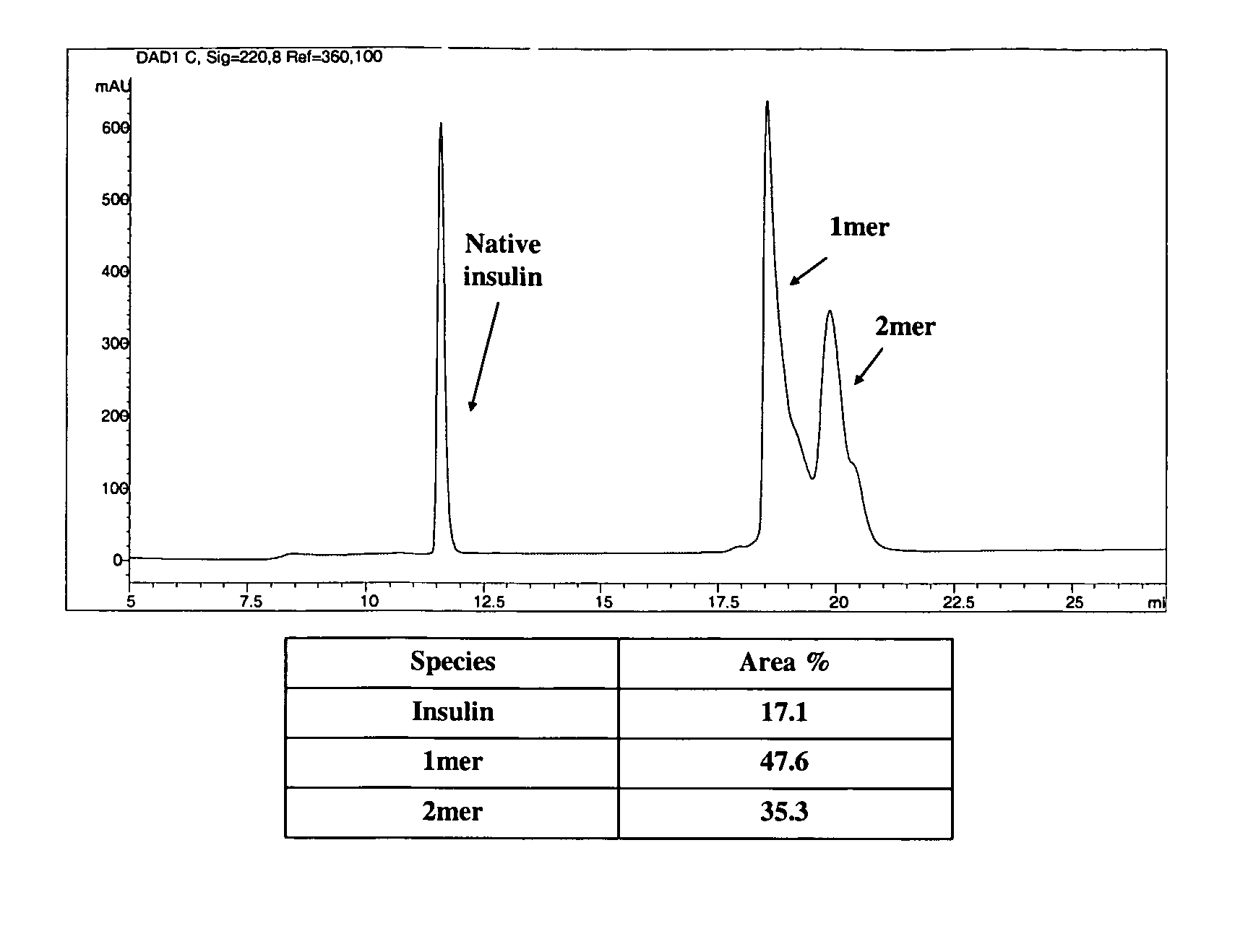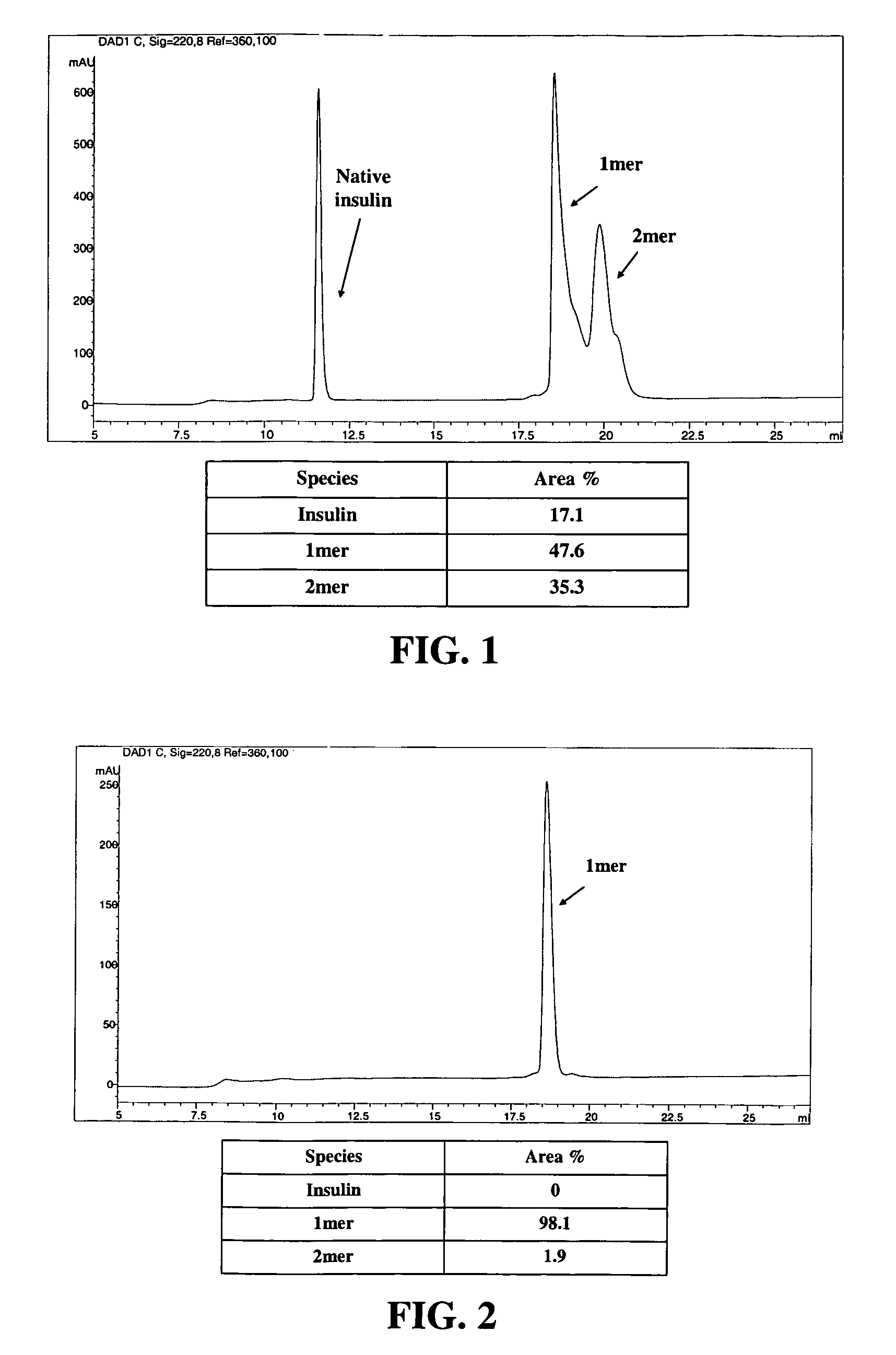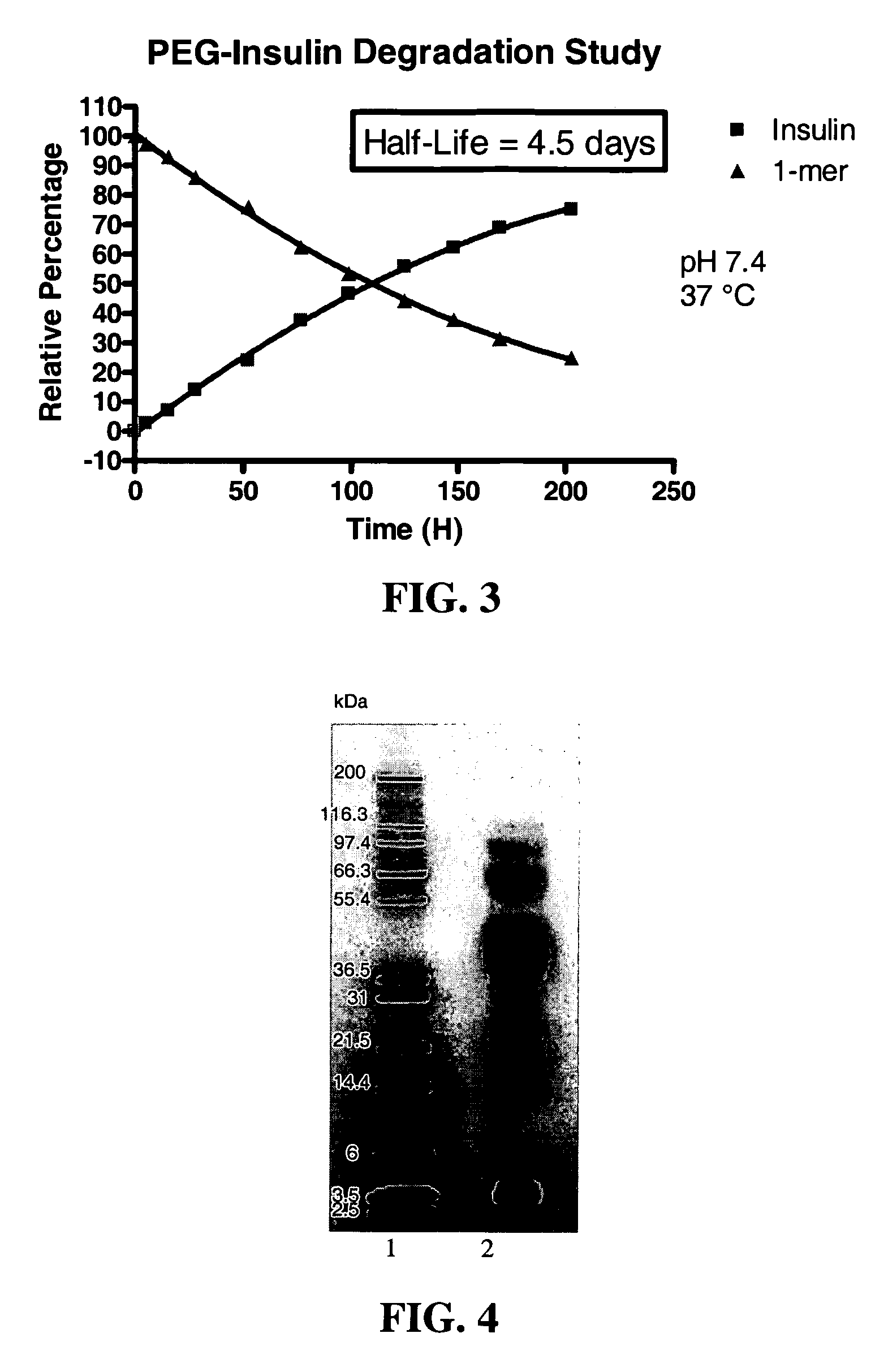Conjugates having a degradable linkage and polymeric reagents useful in preparing such conjugates
a technology of conjugates and polymers, applied in the field of polymeric reagents, can solve the problems of inability to exert the intended pharmacodynamic activity of polypeptides, inconvenient and painful, and relative short half-li
- Summary
- Abstract
- Description
- Claims
- Application Information
AI Technical Summary
Benefits of technology
Problems solved by technology
Method used
Image
Examples
example 1
Preparation of 9-hydroxymethyl-2,7-di(PEG(20,000)-methylamide)fluorene-N-hydroxysuccinimide for Reversible PEGylation
[0691]
A. Preparation of 2,7-di(Boc-amino)fluorene
[0692]Under an argon atmosphere, 2,7-diaminofluorene (2.45 g, 12.5 mmol) was dissolved in 1,4-dioxane (28 mL). Deionized water (14 mL), NaOH 2M (2.2 eq, 27.5 mmol, 13.8 mL) and di-tert-butyldicarbonate (BOC2O) (2.5 eq, 31.3 mmol, 6.82 g) were added successively. The reaction was stirred vigorously for 20 hours at room temperature. Product precipitated as a brown solid. The reaction was quenched by the addition of water and acidification to pH 3 with KHSO4 1M. Product was extracted with chloroform (3×400 mL) and the combined organic layers were washed with ½ saturated brine, dried over Na2SO4 and evaporated. Product was purified by flash chromatography: silica gel 60 Å eluted with 1% methanol in chloroform. The purified yellow solid (5.1 g, ˜99%) was pure by TLC (ninhydrin stain). 1H-NMR (CDCl3): δ (ppm) 7.7 (bs, 2H, NH ...
example 2
PEGylation of Insulin with FMOC PEG2 40K Carbamate
[0700]A. PEGylation
[0701]The polymeric reagent prepared in Example 1, 9-hydroxy-2,7-di(mPEG(20,000)-methylamide)fluorene-N-hydroxysuccinimide, was stored at −20° C. and warmed to room temperature in a dessicator. Insulin (8.9 mg) was weighed out and dissolved in 1 mL DMSO. A molar ratio of 3:1 (PEG:insulin) was used. 184.6 mg of 9-hydroxy-2,7-di(mPEG(20,000)-methylamide)fluorene-N-hydroxysuccinimide was weighed and dissolved in 1 mL acetonitrile and then added to insulin. The reaction was stirred under nitrogen for one hour, and then quenched by diluting it 1:5 with 20 mM acetic acid, pH 3.0 to drop the reaction mixture pH to pH 3.1. The low pH stabilizes the degradable conjugate.
[0702]B. Purification
[0703]Cation exchange was used to purify the 1-mer PEG-insulin conjugate, which is the conjugate having PEGylation at one insulin site, from the 2-mer, which is the conjugate having PEGylation at two insulin sites. A 20 mL SP650 column a...
example 3
Preparation of 9-hydroxymethyl-2,7-di(mPEG(10,000)-amidoglutaric amide)fluorene-N-hydroxysuccinimide (or “G2PEG2Fmoc20k-NHS”)
[0710]The synthesis of 9-hydroxymethyl-2,7-di(mPEG(10,000)-amidoglutaric amide)fluorene-N-hydroxysuccinimide is represented schematically in Scheme 2, below.
[0711]
A. Preparation of 9-Hydroxymethyl-2,7-di(amidoglutaric acid)fluorene
[0712]Under an argon atmosphere, 9-hydroxymethyl-2,7-diaminofluorene dihydrochloride (preparation described in steps A through D in Example 1) was dissolved in deionized water and adjusted to pH 8 with saturated NaHCO3. The mixture was diluted in half with brine and the precipitate was extracted with ethyl acetate. The ethyl acetate layers were dried over Na2SO4, filtered and evaporated for 9-hydroxymethyl-2,7-diaminofluorene (brown powder, 84% isolated yield).
[0713]9-Hydroxymethyl-2,7-diaminofluorene (0.38 g, 1.7 mmol) was dissolved in anhydrous tetrahydrofuran (“THF,” 10 mL) and glutaric anhydride (97%, 2.2 eq, 3.7 mmol, 0.435 g) w...
PUM
| Property | Measurement | Unit |
|---|---|---|
| weight-average molecular weight | aaaaa | aaaaa |
| weight-average molecular weight | aaaaa | aaaaa |
| retention volume | aaaaa | aaaaa |
Abstract
Description
Claims
Application Information
 Login to View More
Login to View More - R&D
- Intellectual Property
- Life Sciences
- Materials
- Tech Scout
- Unparalleled Data Quality
- Higher Quality Content
- 60% Fewer Hallucinations
Browse by: Latest US Patents, China's latest patents, Technical Efficacy Thesaurus, Application Domain, Technology Topic, Popular Technical Reports.
© 2025 PatSnap. All rights reserved.Legal|Privacy policy|Modern Slavery Act Transparency Statement|Sitemap|About US| Contact US: help@patsnap.com



